David Suzuki's Blog, page 21
December 9, 2016
National climate strategy is a positive step, but more is needed
Vancouver/Montreal/Toronto -- The David Suzuki Foundation welcomes the pan-Canadian climate action plan released at today's First Ministers' meeting, but notes that more will be needed to put us on track to meet the Paris Agreement goals of limiting global warming to 1.5 to 2 C.
"This is a good start on the way to a cleaner, stronger future for Canada in terms of the economy and the environment," said David Suzuki Foundation science and policy director Ian Bruce. "For the first time, Canada has built the foundation of an effective national climate plan that, if fully implemented, will put the country much closer to reaching its 2030 emissions target. These policies will need to be improved over time."
The federal government has taken an important leadership role by amplifying some of the best provincial climate solutions at a national scale, and adding a few new ones.
The key solutions included in the plan include:
An increasing price on carbon pollution that will encourage innovation and deployment of clean energy.
A phase-out of coal-fired power.
A green-building standard that will improve the energy efficiency of homes and buildings.
A clean-fuel standard that will cut emissions from transportation fuels.
A $45 billion, 10-year investment commitment to transit, electric vehicles and renewable energy infrastructure.
A requirement to cut methane emissions from the oil and gas sector.
A review mechanism to hold parties accountable for implementing the plan.
Notably absent from the strategy is a zero-emission vehicle standard similar to California and Quebec's that would increase availability and sales of electric vehicles in Canada, although the plan does include measures to expand electric vehicle charging infrastructure. The Foundation is also concerned that if recently approved pipelines and LNG facilities are built, they could prevent Canada from reaching deeper reductions required to keep global temperature rise within safe levels. These projects would also force other sectors of the Canadian economy to reduce emissions more drastically.
Canada's leaders must now lay out a timetable for implementation and provide a full accounting of how newly approved pipeline and LNG projects fit in with the country's plan to reduce emissions by a minimum of 30 per cent relative to 2005 levels by 2030.
"For a plan to be credible, it must not send mixed signals about national priorities," Bruce said. "Responsible action on climate change means shifting from fossil fuels and diversifying the economy to ensure Canadians have good jobs today and into the future while also protecting the environment. That is what is in the national interest."
As large economies around the world take aggressive action on climate change, demand and markets for fossil fuels will decline. Canada must therefore seize the opportunity to transition to a clean economy to strengthen competitiveness, environmental sustainability and quality of life.
30
Media Contacts:
Vancouver
Steve Kux, David Suzuki Foundation: 604-374-4102
Toronto
Gideon Forman, David Suzuki Foundation: 647-703-5957
Montreal
Diego Creimer, David Suzuki Foundation: 514-999-6743
Hey! Want more DSF? Join David Suzuki on Facebook

December 8, 2016
Indigenous people hold the key to caribou survival
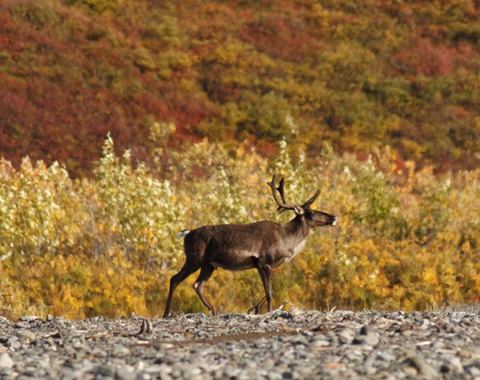
(Credit: Western Arctic National Parklands via Flickr)
When government biologists in Canada want to learn where caribou are, they put radio-tracking collars on some animals and monitor their movements. This gives them a rough idea of where herds are and where they travel, but it doesn't tell them much about a caribou population's history -- travel routes before their habitat was degraded or historical feeding, breeding and calving spots.
It's a critical issue. Northern landscapes where caribou roam, feed and breed have been so badly fragmented by industrial activity -- including forestry, mining, oil, gas and hydro development -- and by climate change impacts and roads and seismic lines that open the areas to hunting and predators, that many herds are in danger of being wiped out. One thing governments could do to ensure caribou survive and thrive in the face of development: Listen to the people who have shared the area with caribou for countless years.
First Nations in Northern Canada have relied on caribou for millennia, for food, clothing and more. They've followed, observed and hunted the animals. They've seen changes in habits and populations as their territories face increasing development pressures. They've handed down knowledge through generations.
The people of Doig River First Nation in B.C.'s Peace River region have watched caribou populations in their traditional territory dwindle to the point that they can no longer hunt them, which is an infringement of their treaty rights. Doig River elders talk about clearcuts that used to be hunting camps, well sites that were once calving grounds, and farms and fields where caribou could always be found in the past. Each caribou herd has different habits and habitat needs and all face steep declines, with some in danger of local extinction.
A new report by the First Nation, David Suzuki Foundation and the Firelight Group examines the Chinchaga boreal caribou herd, the one most familiar to Doig members.
The government's own figures from 2012 show that industrial activity had destroyed or degraded 74 per cent of this herd's habitat -- and it's become worse since then. The recovery strategy for boreal caribou under Canada's Species at Risk Act sets a target of at least 65 per cent undisturbed habitat in each herd's range, and that only gives them a 60 per cent probability of survival. Despite the challenges, the recovery strategy says caribou recovery is feasible. The Doig River report uses traditional knowledge to shed light on how the declines have affected the community and what should be done to restore highly degraded habitat.
Under species at risk and wildlife legislation, federal and provincial governments have the legal and regulatory responsibility to ensure caribou herds recover such that they are sufficiently abundant to be sustainably hunted, and do not rely on interventions from humans like penning or predator control. Without protection from further industrial activity for the habitat that remains, and restoration of degraded habitat, there's little chance of that happening. Without caribou recovery, the people of Doig River can't continue or return to caribou-related traditional activities. With their knowledge, Doig River First Nation is in an ideal position to lead and monitor restoration efforts.
Based on interviews with elders, the Doig River report makes a number of recommendations, including an immediate "rest period" with a halt to industrial development for a minimum of 10 years in at least two-thirds of the Chinchaga historical range; a ban on industrial activity in important calving habitat, especially during the critical late-winter and early-spring periods; fencing off contaminated sites; restoring abandoned well sites; imposing significant fines for oil and gas leaks and spills; a moratorium on forestry in critical areas; closing some areas to hunting; and a Doig River-led, community-based monitoring program to ensure management recommendations are followed.
Policy-makers have ignored the wealth of knowledge that Indigenous peoples hold about caribou and ecosystems for too long. It's time for Indigenous peoples to share their stories of the land at decision-making tables and to play a leadership role in planning and implementing caribou habitat restoration efforts and other land- and water-management issues, with adequate resources to support them. That would be a big "win" all around -- for the caribou, for Indigenous communities, for reconciliation efforts and for all of us who depend on nature for our well-being and survival.
Hey! Want more DSF? Join David Suzuki on Facebook

December 7, 2016
Five tips for getting your letter to the editor published

One of the best ways to tell government to protect the environment is writing a letter to the editor.
The letters page is one of the most popular parts of a newspaper -- and it's not just your friends and neighbours who read it. Local members of Parliament, provincial legislators and city councillors keep an eye on it to stay abreast of their constituents' concerns.
I've been writing letters to editors for over 20 years and always enjoy composing them. The challenge is saying something compelling in a paragraph or two. Think of it as a poem-sized statement of your beliefs.
Here are tips for getting your letter published, and making your voice heard by decision-makers:
1) Keep it topical, timely and tight: Tie your letter to an item in the paper. If that item runs Monday, try to submit your letter by Tuesday or Wednesday. It needs to feel fresh when the editor receives it. Follow length restrictions, typically 150 words or fewer.
2) Just start: At the outset you don't need to know where you'll end up. If you find yourself drawn to an article (agreeing, disagreeing or otherwise engaged) begin writing. Jot down one reaction, one entry point. I often commence a letter knowing my theme only roughly; I discover my thoughts as I go along.
3) Talk as yourself: Editors publish writers who tell distinctive stories or bring to light intriguing facts. Don't be afraid to speak in your own voice. Don't hesitate to express your anger, joy or criticism (or a hybrid) in their uniqueness.
4) Pretty good is great: Folks can be hesitant to write, fearing they won't craft something exactly fitting. Free yourself from perfection. If your letter is in the right region, expressing approximately what you want to say, it's good enough. Send it in.
5) Largely ignore rejection: If your first letters are turned down, don't worry. Editors receive far more material than they can use. Rejection doesn't always mean your missive is weak. Continue to submit. If necessary, try smaller papers where competition is less stiff.
_Gideon Forman is a Climate and Transportation Policy Analyst at the David Suzuki Foundation.
_
Hey! Want more DSF? Join David Suzuki on Facebook

Monarch butterfly year in review: #2016sucks
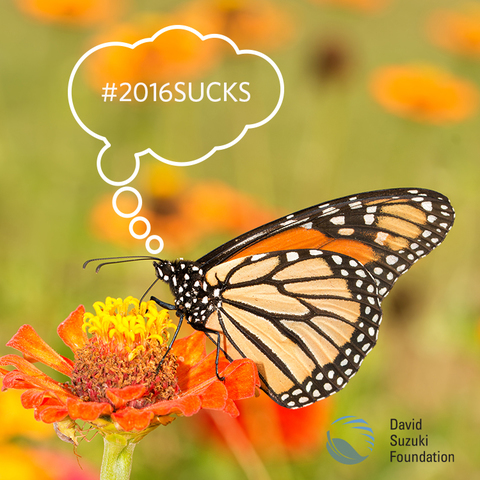
This has been a rough year. We lost pop culture icons Leonard Cohen, David Bowie, Prince and Muhammad Ali. And, according to the Committee on the Status of Endangered Wildlife in Canada, monarch butterflies may not be far behind.
COSEWIC is the scientific body that determines whether species should be legally protected under Canada's Species at Risk Act. Yesterday, COSEWIC released its assessment of 40 species, including a recommendation that the migratory monarch butterfly be formally recognized as an endangered species in Canada.
Monarch populations hit a historic low in winter 2013, when only 35 million butterflies spent the winter in their Mexican overwintering grounds -- a drop of more than 95 per cent from the 1990s. The population made a slight comeback over the past couple of years, but was hit by the worst storm in 30 years this March. It wiped out millions of monarchs days before their return trip. It was a brutally hot summer throughout most of the migratory route between Canada and Mexico. Experts estimate that the population returning to Mexico this summer will once again be close to historic lows.
So, the COSEWIC announcement seems timely, right? Unfortunately, in Canada science routinely gets trumped by politics. As we noted back in 2015, more than 100 imperiled species remain unprotected, despite being similarly recommended for protection by Canada's top scientists.
Three things are clear:
1) The monarchs are in crisis. The endangered assessment means scientists have determined that the monarchs are in grave danger of extinction. The miraculous journey they make between Canada and Mexico each year is at risk of becoming a thing of the past;
2) The process of protecting species in Canada needs to be fixed, as species at risk can't afford to wait; and
3) Monarchs are a species for which we can each do our part.
As scientist Jennifer Heron, co-chair of the COSEWIC Arthropods Subcommittee, observed, "We need to continue to support the conservation of milkweed caterpillar habitat both here in Canada and along the Monarch's migratory journey, and we need to support continued conservation of critical overwintering areas. Otherwise, Monarch migration may disappear, and Canada may lose this iconic species."
Visit here to find out what you can do for monarchs and other essential pollinators in your community.
Hey! Want more DSF? Join David Suzuki on Facebook

December 6, 2016
Caribou TEK and Restoration Study
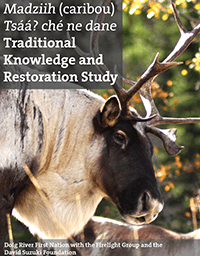
This report by the Doig River First Nation, Firelight Group and David Suzuki Foundation highlights the value of traditional ecological knowledge in helping the Chinchaga caribou herd in the face of numerous threats to their survival.
Hey! Want more DSF? Join David Suzuki on Facebook

Traditional knowledge needed to bring back B.C. caribou
VANCOUVER, DECEMBER 6, 2016 -- Traditional ecological knowledge offers one of the best solutions to help the Chinchaga caribou herd in the face of numerous threats to their survival, according to a report released today by the Doig River First Nation, Firelight Group and David Suzuki Foundation.
The report identifies priority areas of restoration for the herd in northern B.C. The Province of British Columbia must complete a range plan for the Chinchaga herd that identifies restoration objectives by October 2017 to comply with the caribou's Recovery Strategy under Canada's Species at Risk Act (SARA). That's less than a year away.
Based on interviews with members of the northern B.C. First Nation, about 700 kilometres northwest of Edmonton, the report documents multi-generational stories and practical knowledge about hunting, trapping and cultural and spiritual practices relating to caribou.
"My people have harvested caribou in this area for millennia," said Chief Trevor Makadahay. "In only a few generations, industrial exploitation of these lands has diminished caribou populations to the point that there are no longer enough caribou for us to sustain ourselves."
In 2012, the federal government assessed that 74 per cent of the Chinchaga caribou Range had been impacted by forestry, oil and gas operations and roads. The local caribou population is listed as threatened under the SARA. Though some protective measures have been enacted through the Boreal Caribou Implementation Plan, oil and gas development has occurred at a rapid pace within winter ranges and calving habitat, and forestry activities have continued largely unchecked.
"The stories that come from intergenerational, place-based traditional ecological knowledge are far richer than those obtained from formal scientific methods such as radio-collaring and deserve a place at the forefront of recovery planning," said David Suzuki Foundation policy manager Rachel Plotkin.
"This work is a great example of how Indigenous expertise and strong ecological science can be brought together to support First Nations leadership in restoration of species at risk," added Firelight Group ecology director Carolyn Whittaker.
The report highlights that indigenous cultures in Canada have a deep-rooted responsibility to steward the land, especially in light of the failure to adequately do so by government.
"My people have a responsibility to the land to steward it for future generations. There needs to be a place at decision-making tables for our knowledge of the land," Chief Makadahay said. "The elders in my community want to eat caribou again before they die. Doig River First Nation is ready to play a leadership role in planning for caribou habitat restoration."
The report maps priority restoration areas and identifies 14 management recommendations for caribou in the Chinchaga range.
Download a copy of the report at www.davidsuzuki.org. For further information, please contact:
Jode Roberts, David Suzuki Foundation: 647.456.9752 jroberts@davidsuzuki.org
Hey! Want more DSF? Join David Suzuki on Facebook

December 5, 2016
World leaders in Mexico to protect biodiversity. What will Canada have to say?
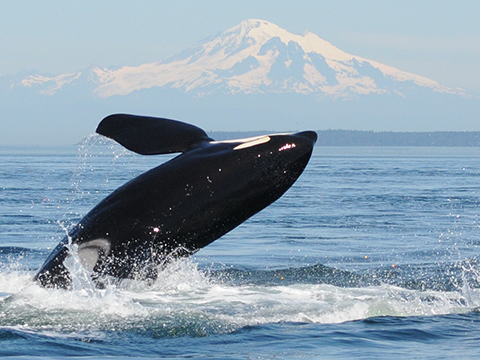
(Credit: Center for Whale Research)
By Jay Ritchlin, Director General Western Canada Region
"We're back." Just over a year ago, freshly elected Justin Trudeau jubilantly broadcast his intention to revive Canada's reputation as a progressive, co-operative and inclusive nation to the international community. But is that how Canada will be represented at the Convention on Biological Diversity's 13th Conference of the Parties (COP 13) in Cancun, Mexico, this month?
The prime minister's mandate letter to the fisheries minister made it clear that keeping oceans healthy is a priority, with a specific promise to protect 10 per cent of coastal and marine areas by 2020. But our country has been inconsistent in international negotiations.
Now into the mandate's second year, it's time to start matching words with action.
When it comes to living up to its global reputation, things looked promising at last year's climate summit in Paris. There, Canada played a leadership role, pushing for agreement on limiting global warming targets to 1.5 C. After 10 years of blocking co-operation on climate change, Canada received well-deserved kudos for stepping forward in international negotiations. Domestic policy has yet to follow suit.
On the international human rights front, we're seeing a different side to Canada. A joint NGO report, "Canada is back, but still far behind," expresses concern for the ineffectual federal watchdog overseeing Canadian multinational corporations.
Which Canada will show up on the international stage when it comes time to conserving biodiversity? Just weeks away from talks in Cancun, the Trudeau government is still leaving us guessing. Will decisions supported there actually be implemented back home?
The Cancun talks on conserving ocean biodiversity will be critical. Many global fish stocks are collapsing due to overfishing, industrial development and the effects of climate change, including ocean acidification.
On the one hand, Canada is making bold statements on marine protected areas. When meeting with U.S. President Barack Obama earlier this year, Prime Minister Trudeau was emphatic that Canada would meet international commitments to protect 10 per cent of marine ecosystems by 2020 and "take concrete steps to achieve and substantially surpass these national goals in the coming years."
On the other hand, at the World Conservation Congress in Hawaii this past September--part of the lead-up to COP 13 in Cancun-- Canada appeared stuck in a previous era. It advocated for weaker standards before supporting motions on protected areas and abstained from votes on increased marine protection that the vast majority of countries supported.
Back in Ottawa, Department of Fisheries and Oceans staff have been developing standards for marine protection independent of the international community. In draft form, they seem designed to allow Canada to justify sidestepping international standards.
Canada should be applauded for committing publicly to meeting the 10 per cent goal. But if in meeting that goal we create paper parks and count areas that don't protect biodiversity, that commitment means nothing.
Let's make sure our recently reinstated scientists and policy-makers are putting their full energy into making tangible, progressive biodiversity conservation designations, not sugar-coating and creating loopholes.
Watering down international decisions could undermine more than protections here in Canada. It could destabilize global biodiversity protection efforts. That's not Canada making a comeback. That's Canada going backwards.
With the likely rollback of U.S. support for environmentally progressive agreements and policy, it's more important than ever that Canada step forward as a leader in the international arena.
Canada has some of the richest biodiversity in the world and a global responsibility to protect it. Decision-makers should consider effects on endangered species such as southern resident killer whales before expanding oil pipelines and tanker traffic.
Canada's "we're back" direction is important, looking to correct the course of the previous Conservative government, who by all accounts blew its 2010 shot at earning a seat on the Security Council because of its regressive stance on a variety of international issues, including climate change.
Hopes to get back in the game in time for the next UN Security Council election in 2020 perfectly match the timing for meeting international marine biodiversity commitments.
But if Canada continues to say one thing while doing another, it's only a short time until our international colleagues' patience wanes and Trudeau's hopeful proclamation rings hollow.
Reputations take time to rebuild. When the global community meets in Mexico to negotiate desperately needed protection for biodiversity, let's make sure Canada behaves in a way that prompts the world to say, "It's good to have you back."
Originally published in The Ottawa Hill-Times.
Hey! Want more DSF? Join David Suzuki on Facebook

It's time to fix Canada's broken environmental assessment process
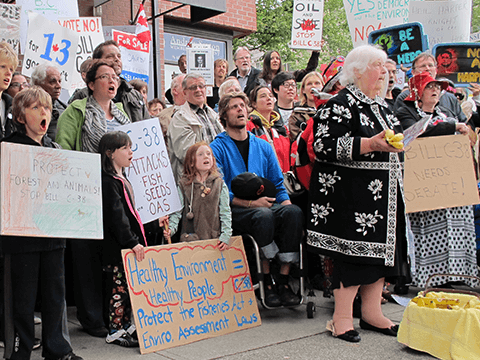
Hey! Want more DSF? Join David Suzuki on Facebook

December 3, 2016
Tanya Tagaq's powerful rallying cry to defend a hurting planet
Video for the song "Sulfur" from the album Retribution, released October 21, 2016 by Six Shooter Records. Retribution was produced by Jesse Zubot.
"Enough of hurting the planet. People ask why I chose to be an activist. It's not a choice."
~ Tanya Tagaq
The David Suzuki Foundation is proud to announce the launch of "Sulfur," the newest video from Inuit throat singer, environmental activist and Polaris Prize winner Tanya Tagaq.
"Sulfur" is a powerful rallying cry to defend a hurting planet. With the recent approval of the Kinder Morgan and Line 3 pipeline expansions, it's more important than ever that people in Canada show decision-makers we won't accept this. We oppose more oil spills, tanker traffic and extinction threats to beloved species such as the orca. If "Sulfur" moves you to action, tell the federal government to rethink these approvals.
Hey! Want more DSF? Join David Suzuki on Facebook
December 1, 2016
Reconciliation requires recognizing rights-based fishing
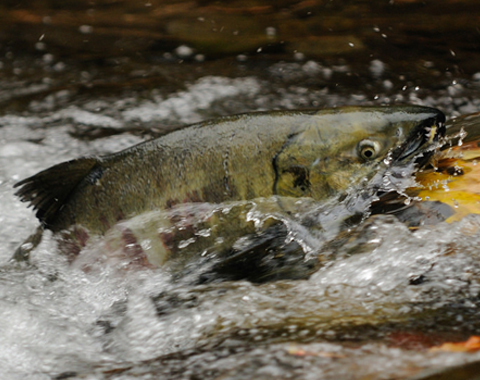
(Photo Credit: Nick Thompsonvia Flickr)
Fishing is as emblematic to Canada as ice hockey. It's also a way of life with a long tradition in coastal Indigenous communities. But since European contact, it's been all but eliminated as an economic development opportunity for them.
As Canada struggles to come to terms with reconciliation, court cases are helping define what Indigenous rights and title mean in day-to-day life. If the federal government is serious about its commitment to a new and respectful relationship with Indigenous peoples, it should set the tone through policies that address historic injustices, such as in commercial fishing practices.
It's been seven years since the court recognized the Nuu-chah-nulth's right to fish for a living. Despite losing two appeals and being given years to work through the court's ruling, Canada has yet to negotiate or put in place court-mandated fishing plans. These Vancouver Island communities are tired of waiting. In September, hereditary chiefs dismissed Fisheries and Oceans Canada's regional director-general from a meeting, telling her not to return until Canada is ready to implement the five nations' right to catch and sell fish.
This and one other court ruling acknowledge an Aboriginal right to commercial fisheries beyond already established food, social and ceremonial fisheries. Nuu-chah-nulth rights to sell fish apply to any fish species in the territory except geoduck. The right can be restricted for valid conservation reasons, as the Nations' fishing plans reflect. But while Canada's courts recognize rights-based fisheries, those rights are not respected. The federal fisheries department approved minimal harvests of gooseneck barnacles and chinook salmon, but turned down everything else the Nuu-chah-nulth proposed.
The court case examined the Nuu-chah-nulth's pre-contact way of life alongside current West Coast fishery regulations. Fishing and fisheries resources trading were recognized as a practices integral to the distinctive cultures of pre-contact society. The Nuu-chah-nulth were acknowledged as a fishing people who depended almost entirely on ocean and river resources for food and economic trade.
Over the past 20 years, many commercial fisheries in Canada have become more ecologically sound, yet economic benefits rarely go to communities living near the resources. Selling marine resources is an important community development opportunity for Indigenous peoples who face erosion of traditional fishing culture alongside limited job opportunities. A 23-kilogram halibut, for example, fetches about $500. It doesn't take many to make a huge economic difference for these small communities. But about 80 per cent of the halibut industry's annual allocation is not fished by those who actually own the quota. Seventy per cent of the halibut's value goes to the leaseholder, with only 30 per cent for the fishing operation. Most of the price to harvesters bypasses coastal communities, often ending up outside of Canada.
Canada's fisheries policies benefit industrial operations over Aboriginal rights-based fisheries. While redeveloping Aboriginal commercial fisheries alongside existing fisheries won't be easy, it's the next evolution. Halibut, salmon, crab, prawn, sablefish and herring catches, of particular interest to the Nuu-chah-nulth, are fully allocated. But the Nuu-chah-nulth were the first to have a commercial fishery and the court found it was unfairly taken from them. So it must be restored.
Canada's Truth and Reconciliation Commission called on all of society to embrace reconciliation, which is guided by the tenets of the UN Declaration on the Rights of Indigenous Peoples. Article 20 says, "Indigenous peoples have the right to maintain and develop their political, economic and social systems or institutions, to be secure in the enjoyment of their own means of subsistence and development, and to engage freely in all their traditional and other economic activities." Despite mixed support from federal and provincial governments for UNDRIP, the commission emphasized its importance for reconciliation to succeed.
Indigenous peoples have been denied their share of marine resources for too long, watching as commercial and recreational fisheries profit from resources on their waters while their boats sit idle. For cultures built on sharing and selling those resources, it's a bitter pill and a threat to cultural survival. It's time for a new relationship built on co-management and equitable division of ocean resources, guided by a shared commitment to ocean conservation. Reconciliation in action would mean restoring the rights of the Nuu-chah-nulth and other Indigenous peoples to fish for a living.
Hey! Want more DSF? Join David Suzuki on Facebook
David Suzuki's Blog
- David Suzuki's profile
- 247 followers



